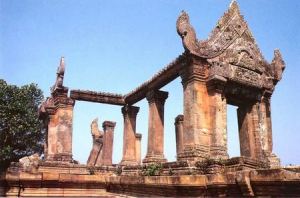Constructed : Early 10th century.
Religion : Hindu (god Shiva)
Style : Banteay Srei
King : Suryavarman I & II ★ 1002 -1050 ★
Location : In Svay Chrum Village, Kan Tout Commune, Choam Khsant District of Preah Vihear province of northern Cambodia. The temple is 140 km from Angkor Wat and 320 km from Phnom Penh.
Comment : Construction of the first temple on the site began in the early 9th century; both then and in the following centuries it was dedicated to the Hindu god Shiva in his manifestations as the mountain gods Sikharesvara and Bhadresvara.
The earliest surviving parts of the temple, however, date from the Koh Ker period in the early 10th century, when the empire’s capital was at the city of that name. Today, elements of the Banteay Srei style of the late 10th century can be seen, but most of the temple was constructed during the reigns of the Khmer kings Suryavarman I (1002 -1050) and Suryavarman II (1113 -1150). An inscription found at the temple provides a detailed account of Suryavarman II studying sacred rituals, celebrating religious festivals and making gifts, including white parasols, golden bowls and elephants, to his spiritual advisor, the aged Brahmin Divakarapandita.
The Brahmin himself took an interest in the temple, according to the inscription, donating to it a golden statue of a dancing Shiva known as “Nataraja”. In the wake of the decline of Hinduism in the region the site was converted to use by Buddhists.













